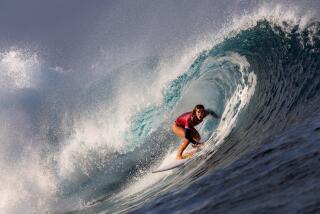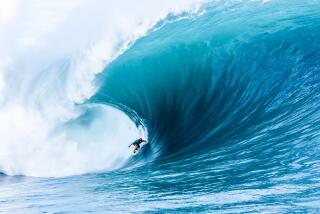How big was it?
- Share via
Greg Noll sat on his surfboard a few hundred yards offshore at Makaha, on Oahu’s west shore. He was alone in the water, just beyond the impact zone where the waves seemed to be detonating rather than breaking, and he was arguing with himself. As he watched the surf thunder nearby, he figured the odds of living through a ride were a little better than even, and these days he had a wife and kids to worry about. But he’d spent much of his life preparing for and dreaming about this exact moment.
The waves were bigger than any he’d ever ridden -- bigger, in fact, than any waves anyone had ever ridden. And they weren’t just huge walls of mush; they surged hard and fast, hurtling down from Kaena Point in ghastly 200-yard slabs. The distant crash of lip on trough jiggled the water beads atop his board, something he’d never seen in his 15 winters in Hawaii. “They were horrible, absolutely horrible,” was how Noll later would describe the waves. “The whole situation gave me a sick feeling.”
For 30 minutes he bobbed in the safe deep water beyond the breakers, debating. And then he chose: better to risk death than suffer the lifelong agony of an opportunity squandered. So he stroked toward the impact zone, and resisted the urge to scramble seaward as a 35-footer reared up. He turned his back to the beast, paddled hard, pushed to his feet and dropped into surf mythology.
Noll’s ride that day soon would become the pinnacle of lore in a sport awash in it. Many surfers can recite the date: Dec. 4, 1969. Today it still stands as the biggest wave ever ridden -- or, more precisely, the biggest ever ridden without the help of tow ropes and jet-powered watercraft.
Most surfers with a sense of history regard the ride’s “biggest-ever” ranking as a tenet of faith, and it maintains that status even though no photos or film clips of the feat have appeared. Or perhaps it maintains that status because no footage has surfaced -- although a Zapruder-like version may exist.
“That wave has grown about 6 inches a year over the last 34 years,” said former surfing world champ Shaun Tomson, who happened to be on the roof of a nearby apartment building that day with a Super 8 movie camera. Tomson was the only person who filmed Noll’s ride. He claims he’s misplaced the footage, but some believe that he simply refuses to release it.
“I think it’s better that myths are shrouded in secrecy and the unknown,” Tomson said. “That’s what myths are all about.”
Despite that missing highlight, listen for a sigh of relief among surf historians when Stacy Peralta’s new big-wave documentary, “Riding Giants,” opens the Sundance Film Festival on Thursday. Peralta, director of the skateboarding documentary “Dogtown and Z-Boys,” unearthed previously unseen film clips and several long-forgotten photos from that day at Makaha. Taken together, they seem to verify that the three-day stretch of giant waves in December 1969 deserves its label as the “Swell of the Century,” and that history probably has not overstated the size or significance of Noll’s wave.
The destructive child of three massive storms that merged in the Gulf of Alaska, the swell of 1969 generated waves up to 50 feet in Hawaii and 20 feet in California. At its peak, the storm featured an unprecedented 2,000-mile-long fetch of wind that stretched from the Aleutian Islands to just north of Hawaii , with the resulting swell energyaimed directly at the islands. “While it’s been said that surfers from the period remember the swell of 1969 as bigger than it really was,” Matt Warshaw wrote in the recently released Encyclopedia of Surfing, “satellite images, along with atmosphere-gauging millibar charts and on-the-beach photographs, all prove that the swell was, in fact, the most powerful on record.”
“Riding Giants” includes shots of some of the 60 homes destroyed by the swell, and the boats tossed across Kamehameha Highway on Oahu’s North Shore. Peralta also zooms in on a long-forgotten photograph of a wave that nearly hammered Noll earlier in the day of his famous ride. The image, taken by Larry Goddard and now under the care of longtime North Shore surfer Randy Rarick, shows Noll’s 11-foot, 4-inch big-wave “gun” hanging in the upper fringe of a massive wall. It looks like a canoe on Niagara Falls.
Eyewitnesses -- including Tomson, Rarick and big-wave trailblazer Fred Hemmings -- have no doubt that Noll’s ride was the biggest up to that point. Hemmings, now minority leader of the Hawaii Senate, ventured into the water at Makaha that day but rode no waves. He strongly believes that Noll stands alone atop the record book.
Some people, however, contend that a few well-known waves ridden over the next three decades may have been as large. Tomson points to a drop that he watched Reno Abellira make at Waimea Bay during the 1974 Smirnoff Pro-Am contest. Rarick cites another Waimea wave ridden by Darrick Doerner on New Year’s Day 1998. Others point to Brock Little’s spectacular wipeout during the 1990 Eddie Aikau memorial invitational, also at Waimea. But given the imprecise calculus of wave-size measurement, comparisons must remain inconclusive. To Hemmings and others, they also demean Noll’s accomplishment.
Some surfers, including Noll, would argue that tow-in surfing has made the discussion moot. Using personal wavecraft, water-skiing ropes and footstraps, tow-in surfers are able to fling themselves into waves that dwarf anything ever ridden by a paddle surfer. “They’re taking it to a new level,” Noll said. “Those are the kids you should be writing about.” And yet even the best tow-in surfers acknowledge that paddling into a giant wave is a much more difficult and frightening thing than getting tugged into one.
Even if a surfer someday were to paddle into a wave bigger than Noll’s, Hemmings said, it almost certainly would pale, given the circumstances. The day of Noll’s ride, Makaha was stormy and unkempt, with giant currents chewing through it. When Noll paddled out, several of Hawaii’s best-known big-wave riders -- George Downing, Buffalo Keaulana and Peter Cole among them -- watched from the beach, and chose to stay there.
“There were no leashes, no Jet Skis, no one else out,” Hemmings said. “I thought I was a pretty brave guy, and I took a look at the waves that day and just paddled in.”
Noll himself wishes that talk about that day and his career in general would disappear. “There’s nothing that puts you to sleep faster than an old guy talking up his past,” he said.
Now 66, Noll was 32 when he rode his historic wave. He had devoted the previous 15 years to attacking the scariest waves he could find, becoming in the process surfing’s first big-wave celebrity. He led a squad of surfers into the water at Waimea Bay the first time it was ridden in 1957. Over the years, he grew from a tall, wiry teenager to a barrel-shaped tank that everyone called “Da Bull.” Surfers knew him for his signature jailhouse-issue surf trunks, his unsightly but sturdy wide-legged stance and his fearlessness.
The Makaha wave that cemented his reputation also nearly killed him. He made it to the bottom, looked up and saw it “starting to break in a section that stretched a block and a half in front of me.”
As the lip threw over him, Noll bailed out, skipping off the water like a stone across a lake before being buried. The turbulence held him under until his lungs burned and his eardrums felt as if they might burst. He clawed to the surface, but more waves followed, and he had to dive deep before each one to dodge the swirling maelstrom. He swam hard for the beach, barely reaching dry sand before the side-shore current swept him into rocks.
The experience transformed Noll’s life. “That wave was so big and powerful and frightening that it kind of cleaned the surfing out of his blood,” Tomson said. Noll soon stopped visiting Hawaii, liquidated his surfboard-making business and moved to Northern California to become a commercial fisherman. “For 15 years, my whole thing was to ride a bigger wave than the year before,” Noll said. “I was getting so cocky I said, ‘Come on, God, show me a wave I can’t ride.’ Then all of a sudden that day came along, and it kind of blew the cap off the whole thing.” He still lives in Crescent City, Calif., where he spends happy hours in a shed behind his riverfront home, crafting much-coveted replicas of historic wooden surfboards.
A few years back, Noll heard a rumor that a former pro surfer had footage of his Makaha ride, and he called Tomson at his home in Santa Barbara. “I asked him to bury it,” Noll said. “I really don’t want to dredge that stuff up. It was what it was.” Tomson, an urbane and photogenic South African, is a knowledgeable surf historian with abiding respect for the sport’s tribal elders. He told Noll not to worry.
Then last year, Peralta also gave Tomson a call. Peralta, 46, is a former teenage skateboard star who’d recently established himself as a guru of the board-sports culture with his edgy 2001 documentary “Dogtown and Z-Boys.”
Tomson agreed to contribute to Peralta’s new big-wave project. When he delivered his celluloid archives, he told Peralta he hadn’t seen the footage in a long time and was worried that the reel containing Noll’s historic ride was missing. Peralta recalled spending many hours going through the raw footage -- uncut reels with standard-issue leader at the beginning and end.
Finally, on one of them Peralta recognized scenes from the December 1969 swell, and he perked up. He knew the chronology of the day: how Tomson had first filmed destruction on the North Shore, then drove to Makaha. As the reel progressed, Peralta’s excitement grew. “There’s the giant closeout waves at Waimea Bay,” he recalled. “There’s the traffic on Kam Highway. There’s the Civil Service evacuating people. There’s the Makaha parking lot. I knew Greg’s wave was coming up. I start going, ‘I got it! I got it! Eureka! It’s coming!’ And then ‘clip,’ it goes to white, and I’m looking at the wall in my office.”
That reel was the only one in the box that ended so suddenly, Peralta said, and he is convinced that Tomson purposely snipped the shot of Noll’s ride. Tomson politely claims that Noll’s wave is on a reel that he hasn’t been able to find. “I’ve actually got it somewhere,” he said, “but I can’t find that specific wave. I seem to be missing one reel.” When told of Peralta’s suspicion about the conspicuously clean cut, Tomson laughed, then joked, “I didn’t mean for it to look so clean.”
Peralta ultimately did use some of Tomson’s footage in his film, mostly peripheral images of the chaos caused by the swell. Lacking the money shot, the filmmaker uses artist’s sketches to re-create Noll’s wild ride. Although Noll’s ride remains undocumented, Peralta insists, it will always merit a position of prominence in the surfing scripture. “What matters is that Greg Noll went out there by himself and sat in the lineup by himself and rode this wave,” Peralta said. “He wasn’t doing it for the cameras. He was doing it because he had to.”
In fact, Peralta actually likes the idea that he might have been denied access to the only existing footage of surfing’s most famous ride. Forever unseen, he said, the legend can forever live on.
But isn’t such thinking blasphemy for a documentarian devoted to historical accuracy?
Peralta’s comeback to that question was quick: “I’m a surfer.”
Steve Hawk is the former editor of Surfer magazine.


